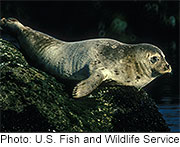
TUESDAY, July 31 (HealthDay News) — A new influenza strain found in New England harbor seals could potentially threaten people as well as wildlife, new research suggests.
Scientists cautioned that viruses like the newly discovered seal flu must be monitored in order to predict new strains and prevent a pandemic flu emerging from animals.
The report was published online July 31 in mBio.
“There is a concern that we have a new mammalian-transmissible virus to which humans haven’t been exposed yet. It’s a combination we haven’t seen in disease before,” report editor Dr. Anne Moscona, professor of pediatrics and of microbiology and immunology at Weill Cornell Medical College in New York City, said in a journal news release.
Another expert agreed that the flu strain could someday pose a threat to people.
“Infections that threaten wildlife and human lives remind us how our health is intermingled on this dynamic planet,” said Dr. Bruce Hirsch, attending physician in infectious diseases at North Shore University Hospital in Manhasset, N.Y. He said that while transmission via direct contact between humans and harbor seals is unlikely, the virus could find other ways to get to people.
“A dangerous virus infecting mammals increases the risk to us — not by direct infection — but by evolutionary development of even more riskier strains,” Hirsch explained. For example, he said, the strain might pass from seals to birds, expand its presence in the environment and mutate in ways that make it easily passed to or between humans.
Scientists from several organizations, including Columbia University and the National Oceanic and Atmospheric Administration, co-wrote the new report. They said that flu viruses found in mammals, such as the H1N1 “swine flu” that emerged in 2009, can put people’s health at risk. The new seal flu, they warned, presents a similar threat to humans.
The researchers analyzed the DNA of a virus linked to the death of 162 harbor seals in 2011 off the coasts of Massachusetts, New Hampshire and Maine. Five autopsies revealed that the seals died from infection with a type of flu known as H3N8.
The report pointed out that the seal flu is very similar to a flu strain found in North American birds since 2002. The virus, the researchers noted, adapted to living in mammals. It also has mutations that are known to make viruses easier to spread and more dangerous. They added the seal flu, which is able to target a protein found in the human respiratory tract, may have the potential to move between species.
The researchers warned that pandemic flu can originate in unexpected ways, so preparation is essential.
“Flu could emerge from anywhere and our readiness has to be much better than we previously realized. We need to be very nimble in our ability to identify and understand the potential risks posed by new viruses emerging from unexpected sources,” said Moscona. “It’s important to realize that viruses can emerge through routes that we haven’t considered. We need to be alert to those risks and ready to act on them.”
Still, viral strains typically must undergo several key mutations to become the source of a human pandemic, Hirsch said.
“Each time the flu virus infects a cell, it is a roll of the dice,” he said. “There are eight separate segments of genes inside the virus — simple viral versions of chromosomes — which recombine at random, producing unique viruses. Cells can be infected with multiple viruses, so a dangerous gene from a bird can get mixed in with a gene that makes it easy to infect humans.”
More information
The U.S. Centers for Disease Control and Prevention provides more information on the spread of flu viruses from animals to people.

